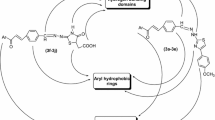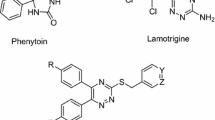Abstract
A series of novel gabapentin derivatives 6a–k and 7a–f were synthesized, and their biological activities were determined. The chemical structures were confirmed by elemental analyses, UV–visible, FT-IR, and 1H NMR spectral studies. The structure–activity relationships (SAR) for anticonvulsant and antioxidant activities were discussed. Compounds 7a–f were evaluated for their possible anticonvulsant activity by Maximal Electroshock Seizure (MES) test, and their neurotoxic effects were determined by rotorod test. Majority of the compounds were active in MES tests. Compounds 7b and 7e showed good protective effect from seizure when compared to standard drug, phenytoin (100 mg/kg). The same compounds showed no neurotoxicity at the maximum dose administered (100 mg/kg). Most of the novel compounds showed DPPH radical scavenging activity, where compounds 6f, 6j, and 7a were the best radical scavengers (IC50 was about 60 μg/ml).


Similar content being viewed by others
References
Aruoma OI (2003) Methodological considerations for characterizing potential antioxidant actions of bioactive components in plant foods. Mutat Res 523:9–20
Ashok K, Satish RS, Avinash MN, Nalinakshya BP, Prashant G, Gajendrasingh RT (2008) Process for the synthesis of gabapentin. US Patent, 0103334 A1:1–6
Blokhina O, Virolainen E, Fagerstedt KV (2003) Antioxidants, oxidative damage and oxygen deprivation stress: a review. Ann Bot 91:179–194
Bowery NG (1993) GABAB receptor pharmacology. Annu Rev Pharmacol Toxicol 33:109–147
Cantuti-Castelvetri I, Shukitt-Hale B, Joseph JA (2000) Neurobehavioral aspects of antioxidants in aging. Int J Dev Neurosci 18:367–381
Capdeville R, Buchdunger E, Zimmermann J, Matter A (2002) Glivec (ST1571, Imatinib), a rationally developed, targeted anticancer drug. Nat Rev Drug Discov 1:493–502
Chadwick DW, Anhut H, Greiner MJ, Alexander J, Murray GH, Garofalo EA, Pierce MW (1998) A double-blind trial of gabapentin monotherapy for newly diagnosed partial seizures. Neurology 51:1282–1288
Elmastas M, Gulcin I, Beydemir S, Kufreviogluo Aboul-EneinHY (2006) A study on the in vitro antioxidant activity of juniper seeds extracts. Anal Lett 39:47–65
Fromm GH (1994) Gabapentin: discussion. Epilepsia 35:S77–S80
Gee NS, Brown JP, Dissanayake VUK, Offord J, Thurlow R, Woodruff GN (1996) The novel anticonvulsant drug, gabapentin (neurontin), binds to the α2d subunit of a calcium channel. J Biol Chem 271:5768–5776
Gulcin I, Beydemir S, Alici HA, Elmastas M, Buyukokuroglu ME (2004) In vitro antioxidant properties of morphine. Pharmacol Res 49:59–66
Holla BS, Rao BS, Shridhara K, Akberali PM (2000) Synthesis, characterisation and biological studies on some mannish bases carrying 2,4-dichlorophenylfurfural moiety. Farmaco 55:338–344
Hollman PCH, Katan MB (1999) Dietary flavonoids: intake, health effects and bioavailability. Food Chem Toxicol 37:937–942
Jeong JM, Kang SK, Lee IH, Lee JY, Jung H, Choi CH (2007) Antioxidant and chemosensitizing effects of flavonoids with hydroxyl and methoxy groups and structure-activity relationship. J Pharm Pharmaceut Sci 10:537–546
Kwan P, Brodie MJ (2000) Early identification of refractory epilepsy. New Engl J Med 342:314–319
Lau KY, Mayr A, Cheung KK (1999) Synthesis of transition metal isocyanide complexes. Inorg Chim Acta 285:223–232
Lima JM (2000) The new drugs and strategies to manage epilepsy. Curr Pharm Des 6:873–878
Loscher WC (2002) Current status and future in the pharmacology of epilepsy. Trends Pharmacol Sci 23:113–118
Loscher W, Schmidt D (1994) Strategies in antiepileptic drug development: is rational drug design superior to random screening and structural variation. Epilep Res 17:95–134
Mattson RH (1998) The role of the old and the new antiepileptic drugs in special populations: mental and multiple handicaps. Neurology 51:504–512
McCabe PH (2000) Role of levetiracetam in the treatment of epilepsy. Expert Opinion Pharmacother 1:633–674
Morton LD, Pellock JM (2000) Overview of childhood epilepsy and epileptic syndromes and advances in therapy. Curr Pharm Des 6:879–900
Pandeya SN, Raja AS (2002) Synthesis of isatin semicabazones as novel anticonvulsants-role of hydrogen bonding. J Pharm Pharmaceut Sci 5:266–271
Piotr P, Bogumil B (2002) Spectroscopic studies and PM3 semiempirical calculations of Schiff bases of gossypol with L-amino acid methyl esters. Biopolymers 67:61–67
Placidi F, Mattia D, Romigi A, Bassetti MA, Spanedda F, Marciani MG (2000) Gabapentin-induced modulation of interictal epileptiform activity related to different vigilance levels. Clin Neurophysiol 111:1637–1642
Raman N, Muthuraj V, Ravichandran S, Kulandaisamy A (2003) Synthesis, characterization and electrochemical behaviour of Cu(II), Co(II), Ni(II) and Zn(II) complexes derived from acetylacetone and p-anisidine and their antimicrobial activity. J Chem Sci 115:161–167
Regesta G, Tanganelli P (1999) Clinical aspects and biological bases of drug-resistant epilepsies. Epilepsy Res 34:109–122
Roopan SM, Khan FRN (2009) Synthesis, antioxidant, hemolytic and cytotoxicity activity of AB ring core of mappicine. Arkivoc 13:161–169
Rosenberg JM, Harrell C, Ristic H, Werner RA, de Rosayro AM (1997) The effect of gabapentin on neuropathic pain. Clin J Pain 13:251–255
Sari N, Arslan S, Logoglu E, Sariyan I (2003) Metal-based antibacterial and antifungal agents: Synthesis, characterization and in vitro biological evaluation of Co(II), Cu(II), Ni(II), and Zn(II) complexes with amino acid-derived. G U J Sci 16:283–287
Shih MH, Ke FY (2004) Synthesis and evaluation of antioxidant activity of sydnonyl substituted thiazolidinone and thiazoline derivatives. Bioorg Med Chem 12:4633–4643
Sridhar SK, Ramesh A (2002) Synthesis, structural determination and antibacterial activity of compounds derived from vanillin and 4-aminoantipyrine. J Indian Chem Soc 41:668–672
Surh YJ, Chun KS, Cha HH, Keum YS, Park KK, Lee SS (2001) Molecular mechanisms underlying chemopreventive activities of anti-inflammatory phytochemicals:down-regulation of COX-2 and INOS through suppression of NF-KB activation. Mutat Res 480:243–268
Tapia A, Rodriguez J, Theoduloz C (2004) Free radical scavengers and antioxidants from baccharis grisebachii. J Ethnopharmacol 95:155–161
Vaya J, Aviram M (2001) Nutritional antioxidants mechanisms of action, analyses of activities and medical applications. Curr Med Chem 1:99–117
Vogel HG, Vogel WH (1997) Drug discovery and evaluation: pharmacological assays. Springer, Berlin, pp 260–261
Yogeeswari P, Sriram D, Thirumurugan R, Raghavendran JV, Sudhan K, Pavana RK, Stables J (2005) Discovery of N-(2,6-dimethylphenyl)-substituted semicarbazones as anticonvulsants effective against various animal models of seizure with GABA-T inhibitory activity. J Med Chem 48:6202–6211
Acknowledgments
One of the authors (LM) is grateful to University Grants Commission, New Delhi, for financial support under UGC-RFSMS scheme, and thanks University of Mysore for the award of Junior Research Fellowship. The authors are thankful to Principal, G Pulla Reddy College of Pharmacy, Hyderabad, India for providing the facilities to carry out the anticonvulsant activity.
Author information
Authors and Affiliations
Corresponding author
Rights and permissions
About this article
Cite this article
Mallesha, L., Mohana, K.N. & Veeresh, B. Synthesis and biological activities of Schiff bases of gabapentin with different aldehydes and ketones: a structure–activity relationship study. Med Chem Res 21, 1–9 (2012). https://doi.org/10.1007/s00044-010-9498-8
Received:
Accepted:
Published:
Issue Date:
DOI: https://doi.org/10.1007/s00044-010-9498-8




